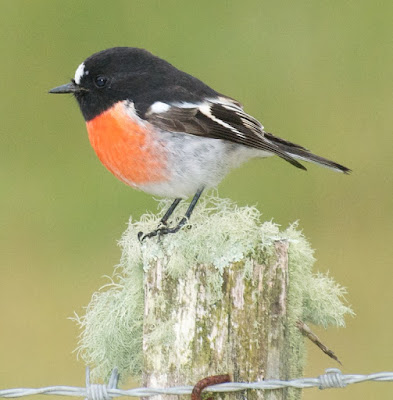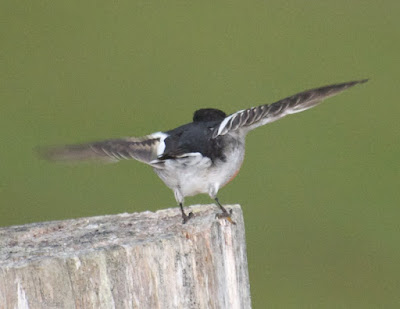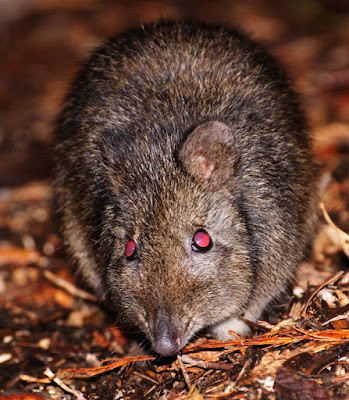The Tasman Peninsula, south and east of Hobart but reachable by road only by swinging north across the Derwent, combines both natural and human history. I planned our visit there, on March 21. 2014, so that we could end up at Port Arthur - now a popular tourist attraction, but once the grim destination for many a transported criminal, bound for Van Diemen's Land.
After our long day on Bruny Island, we allowed ourselves a bit of a late start, a casual drive and a stop at a highly-recommended fish-and-chip shop (a highlight of the day for Ryan, who can never get enough fish and chips). This wasn't so much a shop as an unloading dock right on the coast, at the narrow neck of land that connects the Tasman Peninsula to the mainland. It featured an Australian Fur Seal (Arctocephalus pusillus), possibly from the South Bruny haulout we visited the day before. hanging out by the wharf in the hope of a scrap or two.
The seacoast along the eastern side of the peninsula boasts some striking geological features. At Eaglehawk Neck, the narrow belt of land that separates the northern and southern portions of the Peninsula, the Tessellated Pavement Sate Reserve, where fracturing and erosion have produced a peculiar mosaic-like pattern in the rocks on the shore. It was raining, and we decided not to negotiate the steps to the rocks below.
Even more impressive (and better known) is the Tasman Arch, the much-photographed remains of a collapsed sea-cave.
The seacoast along the eastern side of the peninsula boasts some striking geological features. At Eaglehawk Neck, the narrow belt of land that separates the northern and southern portions of the Peninsula, the Tessellated Pavement Sate Reserve, where fracturing and erosion have produced a peculiar mosaic-like pattern in the rocks on the shore. It was raining, and we decided not to negotiate the steps to the rocks below.
Even more impressive (and better known) is the Tasman Arch, the much-photographed remains of a collapsed sea-cave.
Ryan wanted to see more Tasmanian Devils (Sarcophilus harrisii) now that we were actually in Tasmania, but our chances of coming across one of these increasingly rare animals in the wild was a slim one. That meant a stop at the Tasmanian Devil Conservation Park, a somewhat euphemistically-named small zoo (and rehabilitation centre) devoted to the native fauna.
And yes, it does have Tasmanian Devils, so Ryan was very happy indeed.
And yes, it does have Tasmanian Devils, so Ryan was very happy indeed.
Mixed with them were Cape Barren Geese (Cereopsis novaehollandiae), peculiar waterfowl largely restricted, in Tasmania, to coastal islands in the north. Their relationship to other ducks and geese has been a matter of some controversy, but they may be related to long-extinct flightless geese (Cnemiornis spp.) from New Zealand.
The Port Arthur Historic Site, on a long inlet on the southern side of the peninsula, is unmissable for anyone interested in a sorry chapter of Australia's history (and if you haven't read it, Robert Hughes' The Fatal Shore is a must). There is a great deal to say about it that has little to do with nature (including a horrific mass shooting in 1996 that led to Australia's extremely strict gun laws - an event I didn't know about at the time of our visit).
The grounds of the penal colony, though, have their share of natural history as well.
Superb Fairy-Wrens (Malurus cyaneus), for example, hopped around practically at our feet. This is a either a young male or a male in eclipse (non-breeeding) plumage, with only a bit of his breeding finery left on his tail.
Females have red bills, mostly brown tails and a bit of bare red skin on the lores and around the eye.
A number of fenceposts in the central garden were decorated with Scarlet Robins (Petroica boodang), either extremely colourful males...
...or more subtly-plumagaed, but still attractive, females.
Petroica robins indulge in wing-waving or wing-flicking displays (I have seen this in more than one species), and the Scarlet Robins at Port Arthur were no exception. These males seemed to be trying out for a merit badge in semaphore.
Females wing-wave too.
Masked Lapwings (Vanellus miles) strode about the lawns or checked for insects in the flower beds...
...while Green Rosellas (Platycercus caledonicus), common but found only in Tasmania, perched over our heads. This is the largest and least colourful of the rosellas, parrots found in one form or another almost all around Australia.
Convicts and their keepers were not the only Europeans to take up residence at Port Arthur. European Blackbirds (Turdus merula) were first brought to Tasmania as early as 1827, not long after the firts convict shipments; according to one account they were "greeted with joy by the homesick settlers". The joy eventually gave way to dislike as the birds became major pests of fruit crops. A campaign was waged to eradicate them, including a bounty, from 1941 to 1947. Although almost 80,000 birds were killed the campaign failed, and Blackbirds remain common in Tasmania today.
The gardens at Port Arthur contain their share of European imports, too - pears, apples and the like - but are also home to native plants. Pink Mountain Berry (Leptecophylla juniperina) is a member of the southern heath family (Ericaceae, formerly classed as Epacridaceae). It grows in Tasmnia and adjacent Victoria, and reappears in New Zealand. It and its relatives are collectively known as cheeseberries, from the resemblance of the fruits to tiny, wax-covered wheels of cheese; the other cheeseberries are confined to Tasmania.
A walk down to the harbour led us to Neptune's Necklace (Hormosira banksii), a common brown alga composed of strands of inflated, bead-like segments. It is, among other things, edible, though we didn't try any.
By now it was starting to get dark, and hte garden birds began to be replacedby mammals. Ryan and I went out to have a look while Eileen relaxed with a coffee.
European Rabbits (Oryctolagus cuniculus) had been around for much of the afternoon, but we now saw more of them out on the lawns.
A few birds were still about, notably a Tasmanian Native Hen (Tribonyx mortierii) - only slightly less tame here than at the botanical gardens in Hobart.
It was Ryan who came up with the best find of the day - a little kangaroo-like animal, about the size of a rabbit, crouching under a hedge. He eagerly called me over for a look at it, and to my surprise and delight it turned out to be a Long-nosed Potoroo (Potorous tridactylus), the first (and so far, only) potoroo I had ever seen.
Potoroos used to be called rat-kangaroos, and they were once widespread in Australia. As with many other small marsupials, the introduction of foxes and cats from Europe meant death, or even extinction, for many of them. The Broad-faced Potoroo (Potorous platyops) has not been seen since 1875. The Long-nosed Potoroo is still widespread, and even common, in eastern Australia, but Tasmania - where there are, fortunately, no foxes - is the likeliest place for a casual visitor to see one.
Still, Ryan and I were lucky. Potoroos are nocturnal, and keep to the undergrowth, so there is no guarantee of turning one up even in a place like Port Arthur, where thet must surely be used to curious human onlookers. Besides, one of the first Europeans ever to encounter one was Charles Darwin, who dug one out of a burrow while sailing around the world on the Beagle, and a naturalist (or his grandson) can't be in better company than that.
By now it was quite dark, and time to go - but not before encountering our first wild Tasmanian Padamelon. In this case (unlike our unique encounter with the potoroo), it was to be the first encounter of many.




































Congrats to Ryan for spotting that Pototoo! It definitely looks rather rat-like. I'm guessing it was quite docile too, letting you watch it while it foraged. Anyway, a great find.
ReplyDeleteI agree - certainly a highlight for me, and Ryan still talks about it.
Delete